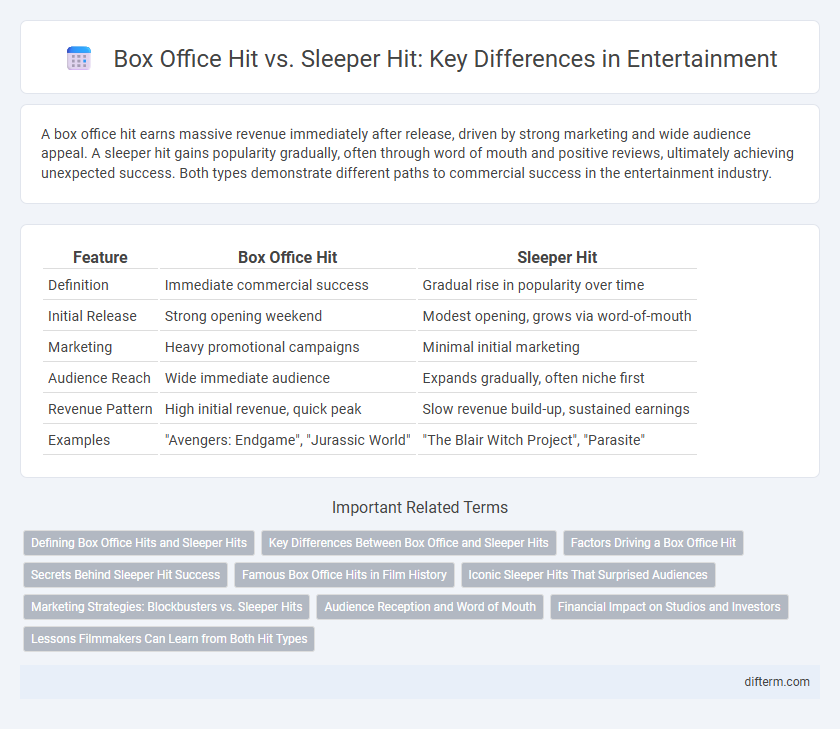A box office hit earns massive revenue immediately after release, driven by strong marketing and wide audience appeal. A sleeper hit gains popularity gradually, often through word of mouth and positive reviews, ultimately achieving unexpected success. Both types demonstrate different paths to commercial success in the entertainment industry.
Table of Comparison
| Feature | Box Office Hit | Sleeper Hit |
|---|---|---|
| Definition | Immediate commercial success | Gradual rise in popularity over time |
| Initial Release | Strong opening weekend | Modest opening, grows via word-of-mouth |
| Marketing | Heavy promotional campaigns | Minimal initial marketing |
| Audience Reach | Wide immediate audience | Expands gradually, often niche first |
| Revenue Pattern | High initial revenue, quick peak | Slow revenue build-up, sustained earnings |
| Examples | "Avengers: Endgame", "Jurassic World" | "The Blair Witch Project", "Parasite" |
Defining Box Office Hits and Sleeper Hits
Box office hits are films that achieve immediate commercial success, generating high revenue during their initial release weeks. Sleeper hits gradually build an audience through positive word-of-mouth and critical acclaim, often outperforming initial box office expectations over time. Both types demonstrate strong audience engagement but differ in the timing and scale of their financial impact.
Key Differences Between Box Office and Sleeper Hits
Box office hits achieve immediate commercial success with high opening weekend revenues driven by strong marketing and star power, while sleeper hits gradually gain popularity through positive word-of-mouth over time. Box office hits typically dominate charts in their release week, whereas sleeper hits often start with modest earnings and build momentum steadily. These distinctions highlight the impact of initial audience anticipation and long-term engagement on a film's financial performance.
Factors Driving a Box Office Hit
Box office hits typically generate massive revenue through extensive marketing campaigns, star-studded casts, and wide theatrical releases, capitalizing on strong audience anticipation and brand recognition. Sleeper hits often rely on positive word-of-mouth, critical acclaim, and niche appeal to gradually build momentum despite limited initial exposure or modest marketing budgets. Key factors driving a box office hit include strategic release timing, franchise popularity, and effective promotional strategies that maximize audience reach and engagement.
Secrets Behind Sleeper Hit Success
Sleeper hits achieve success through strong word-of-mouth, low marketing costs, and unique storytelling that resonates with niche audiences. Unlike box office hits that rely on massive opening weekends and high-budget promotions, sleeper hits build momentum over time, often leveraging social media and critical acclaim. This organic growth helps them outperform expectations and generate sustained revenue long after initial release.
Famous Box Office Hits in Film History
Famous box office hits like "Avengers: Endgame" and "Titanic" achieved record-breaking global ticket sales and massive opening weekend revenues, solidifying their status as blockbuster events. In contrast, sleeper hits such as "The Blair Witch Project" and "Paranormal Activity" gained popularity through word-of-mouth and modest budgets, ultimately generating significant profits over time. These films demonstrate different paths to financial success in the entertainment industry, with box office hits driven by large marketing campaigns and established franchises.
Iconic Sleeper Hits That Surprised Audiences
Iconic sleeper hits like "The Blair Witch Project" and "Slumdog Millionaire" defied expectations with low budgets and limited marketing yet achieved massive box office success through word-of-mouth and cultural impact. These films became landmarks in entertainment by influencing genre trends and inspiring independent filmmakers worldwide. Their impressive revenue growth over time highlights the power of audience engagement beyond traditional blockbuster marketing strategies.
Marketing Strategies: Blockbusters vs. Sleeper Hits
Blockbusters rely on massive marketing budgets, wide theatrical releases, and aggressive advertising campaigns to generate immediate audience awareness and box office success. Sleeper hits depend on targeted, grassroots marketing, positive word-of-mouth, and strategic use of social media to gradually build a loyal audience over time. Effective marketing strategies for blockbusters include star-studded trailers and international promotions, while sleeper hits capitalize on niche appeal and organic audience engagement.
Audience Reception and Word of Mouth
Box office hits often generate massive initial audience turnout driven by pre-release marketing and star power. Sleeper hits, however, rely heavily on positive word of mouth and gradually build a loyal audience over time. Strong audience reception and organic buzz can significantly boost a sleeper hit's long-term success and profitability.
Financial Impact on Studios and Investors
Box office hits generate immediate and significant revenue, often exceeding production budgets by multiple folds, securing lucrative returns for studios and investors. Sleeper hits usually start slow but build momentum through positive word-of-mouth, ultimately providing steady, long-term financial gains and reducing risk exposure. Both types of hits positively impact ancillary markets like streaming, merchandising, and international sales, further enhancing overall profitability.
Lessons Filmmakers Can Learn from Both Hit Types
Box office hits demonstrate the value of strong marketing campaigns and mass appeal, teaching filmmakers the importance of wide audience reach and franchise potential. Sleeper hits highlight the power of word-of-mouth, niche targeting, and organic growth, showing creators how smaller budgets and unique storytelling can build lasting impact. Combining these approaches, filmmakers can optimize both immediate returns and long-term cultural resonance.
box office hit vs sleeper hit Infographic

 difterm.com
difterm.com